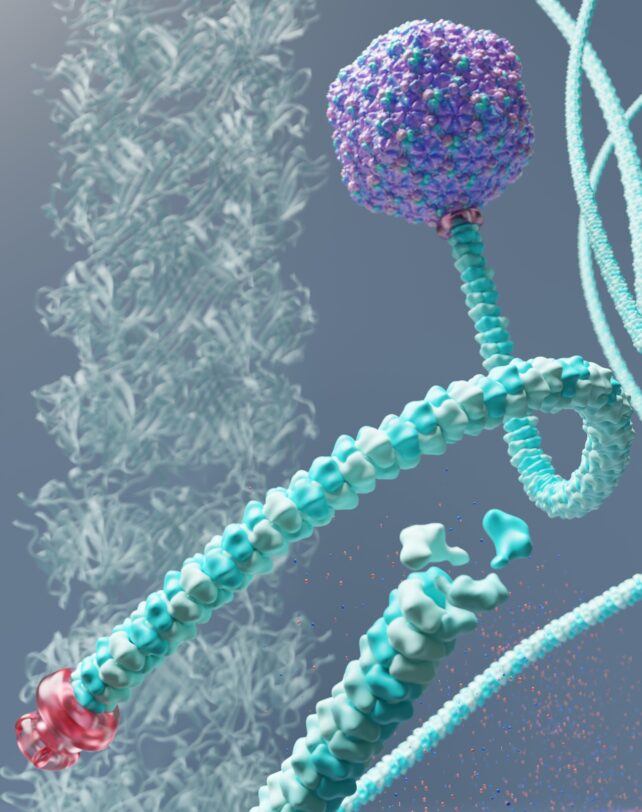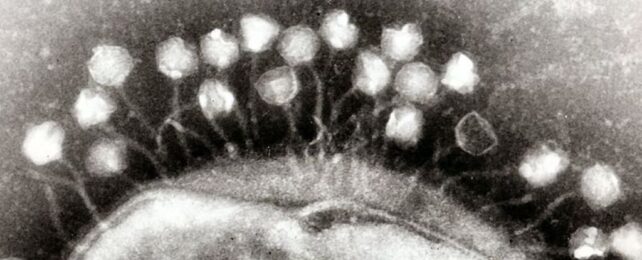For billions of years, viruses and bacteria have been locked in a never-ending arm's race, and it has caused one predator to evolve "a monster of a tail".
The unique bacteria-devouring virus, or bacteriophage, is officially named P74-26, though it's more colloquially known as the 'Rapunzel' virus.
Like the absurdly long locks of the fairytale princess, the pathogen's 'ponytail' stands out in a crowd of its peers.
At nearly a micrometer in length, the appendage is 10 times longer than most other bacteriophages.
In fact, it has the longest tail of any known virus and, strangely enough, the most stable one, too.

According to new research, this impressive appendage is probably what allows the Rapunzel virus to find and puncture one of the toughest bacteria on Earth and in one of the most inhospitable environments.
In bubbling hot springs that reach temperatures well over 77 °C (170 °F), the Rapunzel virus lives by infecting the bacterium Thermus thermophilus and using the other cell's machinery to reproduce and multiply.
Stitching together many images of the virus's tail at various points of its construction, scientists were able to unravel its unique structure. Computer simulations further elucidated the "highly interwoven network of interactions" that coordinate to build this impressively long probe.
"We used a technique called cryo-electron microscopy, which is a huge microscope that allows us to take thousands of images and short movies at a very high magnification," explains microbiologist Emily Agnello from the University of Massachusetts (UMass) Chan Medical School.
"By taking lots of pictures of the phage's tail tubes and stacking them together, we were able to figure out exactly how the building blocks fit together."
The tails of bacteriophages come in a variety of lengths and styles: some long, some elastic, some short, and some stiff. These molecular 'machines' have evolved to recognize specific bacterial host cells before penetrating them and then delivering their genome to the cytoplasm for replication.
Given the lock-and-key nature of this attack, there is a great diversity of tails among bacteriophages, which are found in virtually every habitat on Earth. But exactly how do these tails differ?
To date, scientists have characterized very few phage-host interactions, and now that antibiotic resistance is a growing threat to human health, experts are turning to phages for ideas on how to defeat superbugs.
For instance, the Rapunzel virus's tail seems to be such a threat to bacteria because of how its building blocks interlock and stack up.
Despite its sheer size, the virus's tail relies on half the number of building blocks as other bacteriophages, researchers say, and that seems to make all the difference.
"We think what has happened is that some ancient virus fused its building blocks into one protein," says biochemist Brian Kelch from UMass.
"Imagine two small Lego bricks are fused into one large brick with no seams. This long tail is built with larger, sturdier building blocks. We think that could be stabilizing the tail at high temperatures."

These extra-sturdy subunits stack with a 'ball and socket'-like mechanism similar to Lego bricks, which have one side studded and the other pocketed.
In viruses, each of these building blocks is a sort of ring-like shape, which means the whole tail forms a hollow tube when completed. This is the channel along which the virus sends its genome once it has penetrated a bacterial cell.
"Our research finds that these building blocks can change shape, or conformation, as they come together," says Agnello.
"This shape-changing behavior is important in allowing the building blocks to fit together and form the correct structure of the tail tube."
The Rapunzel virus tail is exceptionally long, which seems to give it extra power in locking onto and penetrating bacteria. At the same time, however, that sheer length means there's more of a chance for the tail's assembly to go wrong.
Researchers think there must be internal mechanisms that keep the developing tail on the right path, and these mechanisms are probably shared with other phages.
Understanding how they work could one day help scientists create better treatments in the fight against deadly bacteria.
"I believe that studying unique, interesting things can lead to findings and applications that we can't even yet imagine," says Agnello.
Now that they know how the virus' tail forms, researchers plan on genetically altering its length to see how that might change its interactions with bacteria.
No matter the outcome, these experiments are sure to teach us something new.
The study was published in the Journal of Biological Chemistry.
